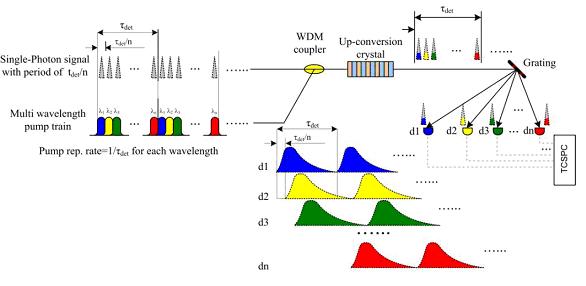System data breaks the jitter limitation with NIST up-conversion detectors
Home Publications Links Collaborations Team Developments Opportunities
<?xml:namespace prefix = st1 /?>
System data rate breaks the jitter limitation with NIST up-conversion detectors
NISTs Quantum Communications research group has demonstrated a method to increase the date rate of quantum communication systems equipped with up-conversion detectors. The demonstration is implemented by using a novel multi-wavelength pumping scheme.
NISTs Quantum Communications research group, based in ITL, has demonstrated a method to increase the temporal resolution of quantum communication systems equipped with their up-conversion detectors using a novel multi-wavelength pumping scheme.
The maximum achievable data rate of a quantum communication system can be critically limited by the efficiency and temporal resolution of the system's single-photon detectors. Frequency up-conversion technology can be used to increase detection efficiency for IR photons. NIST researchers developed a scheme to improve the temporal resolution of an up-conversion single-photon detector using multi-wavelength optical-sampling techniques, allowing for increased transmission rates in single-photon communications systems.
Up-conversion detectors offer a number of significant advantages over other detection technologies for detection of photons in the elusive 1310 nm NIR range. To date, several groups have successfully developed highly efficient up-conversion single-photon detectors in the near-infrared range based on periodically poled lithium niobate (PPLN) bulk or waveguide devices integrated with Si APDs. These detectors boast very high detection efficiency. However, in an up-conversion detector with a continuous wave (CW) pump, the temporal resolution is determined by the Si APD. The jitter-limited temporal resolution becomes a bottleneck as the transmission rate increases in a quantum communication system.
<?xml:namespace prefix = v /?>
Fig. 1. Schematic diagram of up-conversion single-photon detection with multi-wavelength optical sampling. A sequence of n spectrally and temporally distinct pump pulses are used to sub-divide the minimum resolvable time bin, τdet, of conventional Si APDs, increasing the temporal resolution of the overall system by a factor of n. The incident single-photon signal is combined with the sequence of pump pulses with a wavelength division multiplexer (WDM). Detection events from each of the n Si APDs are time-tagged with time-correlated single-photon counting (TCSPC).
To increase the temporal resolution of an up-conversion detection system beyond that of its constituent Si APDs, a sequence of spectrally and temporally distinct pump pulses can be used to sub-divide the minimum resolvable time period. This technique is illustrated in Fig. 1, where pump pulses with different wavelengths are used to sample the incident single-photon signal in intervals. When a signal photon enters and co-propagates with one of the strong pump pulses in a quasi-phase matched sum-frequency crystal, it can be up-converted to the visible range. The specific wavelength of the up-converted photon is determined by the wavelength of the pump pulse with which it interacted. A subsequent dispersive element such as a grating can separate the up-converted signal photons and distribute them to an array of Si APDs. In such a configuration the sampling period for each Si APD is allows it to accurately resolve the signal without ambiguity due to the detector's temporal response.
Lijun Ma, Joshua Bienfang, Oliver Slattery and Xiao Tang, "Up-conversion single-photon detector using multi-wavelengh sampling techniques".
CONTACT: Xiao Tang (ITL), ext. 2503

